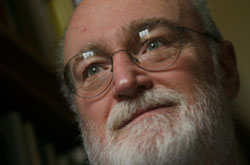Smith and the Ideal Type
As you recall from the first post in this series, on several occasions Robert M. Price has accused Jonathan Z. Smith of not understanding and grossly misapplying Max Weber’s ideal type. For example, in Price’s critique of Drudgery Divine (see: Higher Critical Review), he wrote:
In the same way, Smith seems unwilling to admit the viability of an ideal type of the dying-and-rising god mytheme. If the various myths of Osiris, Attis, Adonis, et. [sic] al. do not all conform to type exactly, then they are not sufficiently alike to fit into the same box, so let’s throw out the box. Without everything in common, he sees nothing in common. [Price 1996]

He has recycled this accusation elsewhere, sometimes copying and pasting the “et.” error, sometimes not. Price is quite proud of his “throw-out-the-box” turn of phrase, as he should be — if he were correct.
Fortunately for us, Smith actually discussed ideal types, so we have a window into his thinking on the matter. In a footnote on p. 99 of Drudgery Divine, he refers to a book by one of his students, Eugene V. Gallagher. In Divine Man or Magician, Gallagher examined the work of Ludwig Bieler, whose studies of the divine man (θεῖος ἀνήρ) type were groundbreaking and insightful, but often misunderstood.
Smith put it this way:
While justifiable criticisms can be brought against both Bieler’s theoretical presuppositions and his methodological procedures, it is sadly revealing and utterly characteristic that most scholars of early Christianity have fundamentally misunderstood his enterprise, in that they have historicized the Typus and viewed the second comparative step as genealogical. E. V. Gallagher, Divine Man or Magician? Celsus and Origen on Jesus (Chico, 1982): 10-18, in the series, SBLD, 64, offers a sophisticated account of Bieler’s enterprise, and usefully compares his work to Max Weber’s notion of the ‘ideal type’. [Smith 1990, p. 99]
Let’s examine the two fundamental errors Smith has identified above. First, some scholars forgot (did they ever know?) that the ideal type is a modern construct. The “theios aner” exists not in the historical past, but in the realm of ideas. Hence, to criticize Bieler’s type as an anachronism misses the point entirely. Second, when Smith criticizes scholars on the basis of genealogy, he means they’ve jumped the gun on issues of dependence and who borrowed from whom. The second step should be that of analogy, which includes seeking evidence of both difference and similarity. In To Take Place, he wrote:
Comparison requires the acceptance of difference as the grounds of its being interesting, and a methodical manipulation of that difference to achieve some stated cognitive end. The questions of comparison are questions of judgment with respect to difference: What differences are to be maintained in the interests of comparative inquiry? What differences can be defensibly relaxed and relativized in light of the intellectual tasks at hand? [Smith 1992, p. 14, emphasis mine]
Bieler’s Gesampttypus
Gallagher wrote Divine Man or Magician? as his doctoral dissertation under the tutelage of Smith, who is listed as his advisor. So not only did Smith mention Gallagher favorably, but he also had intimate knowledge of the work in question.
Bieler admits from the outset that he is not interested in historical development but rather in the “Gesamttypus”* or even the Platonic idea of the divine man. Individuals will never manifest in perfection all the essential characteristics of the type, but they all, more or less, bear its stamp. [Gallagher 1982, pp. 10-11, emphasis mine]
*[i.e, “overall type” or “comprehensive type]

Bieler created his Typus by looking for common characteristics frequently found among the several examples. He believed that distinguishing characteristics “wore down” over time. Gallagher says that Bieler freely drew from myths, sagas, and legends, as he cared about how the divine men were viewed over time rather than from arbitrary snapshots or instances. From these sources, one could derive their essential nature (which may or may not be historically accurate.)
To reiterate, Bieler was creating a model to facilitate modern study. When later scholars dismissed him for finding a type that didn’t exist in the historical record or in the minds of ancient philosophers and historians, they missed the point.
By misapprehending Bieler’s use of the divine type and by appealing to his work as support for the existence of a Hellenistic type of the divine man, scholars like [Helmut] Koester and [Hans Dieter] Betz have perpetrated an historical anachronism. Such a type may be there, but that is not exactly what Bieler was getting at. For Bieler, it takes the efforts of the scholar to raise the disparate indications in the Hellenistic literature to the level of a useful research tool by extracting from them common features and recurrent patterns. Such theoretical models are useful in their “explanation of the virtual tendencies of a system, in light of which actual discrepancies may be investigated.” In their use of Bieler, recent studies have frequently mistaken his model of virtual tendencies for a description of empirical reality. Moreover, from Bieler’s point of view it is not a question of “far-reaching theological developments” of the Hellenistic concept of the divine man in the gospel traditions, nor is it a question of the early Christian adaptation of an appealing device from the Jewish missionary tradition. Rather, it is a question of how each “actual” appearance of the figure of the divine man conforms to and departs from the model of “virtual” tendencies which Bieler has constructed. By retrojecting Bieler’s ideal type into the Hellenistic world, scholars have obfuscated both the gains and limitations of typological analysis. [Gallagher 1982, pp. 16-17, bold emphasis mine]
Smith not only fully understood the definition of an ideal type, but he also understood its purpose. When comparing, for example, Christianity to an ancient near east mystery religion, it would help to have a third term to which one can compare them, lest one fall into apologetic traps. “Help” is probably not a sufficiently strong word. Smith, I think, would have considered it essential.
Smith Thanked Frazer
In fact, you may be surprised to learn that Smith praised Sir James Frazer for being on the right track. He would eventually, of course, set aside the “dying-and-rising pattern” championed by Fraser. However, the idea of comparing the religions of late antiquity to what Smith called a “third term” (rather than comparing everything non-Christian to some normative concept of Christianity) was a crucial contribution.
From our comparativist perspective, regardless of the judgments, yet to be made, as to the genealogical validity of the ‘dying and rising’ myth with respect to early Christianity, the observation brought forth in the first chapter, with respect to Dupuis, must, now, be repeated here. The work of Frazer and Pfleiderer, as well as their intellectual descendents, are significant because they introduced a third term to the comparative project. At their best, what these scholars proposed was not a comparison between early Christianity and some other Late Antique religion with respect to this or that detail or word, a comparison which invites conclusions as to borrowing or dependence, but rather the comparison of both with respect to a more generic (in this case, a seasonal) pattern, a comparison which resists conclusions as to borrowing or dependence. Although carried out in a far from consistent manner, for this methodological advance, we owe these predecessors a debt of gratitude.
Clearly, he understood ideal types. And he appreciated the requirement of a “third term,” preferably a viable general pattern to provide a neutral framework from which to investigate similarities and differences. Smith knew that differences are what make the process of comparison interesting and useful.
So what’s going on here? We’ll look at the real reason Smith rejected the dying-and-rising pattern in the coming posts.
Price, Robert M. Journal of Higher Criticism 3/1 (Spring, 1996), pp. 137-145.
Smith, Jonathan Z. Drudgery Divine: On the Comparison of Early Christianities and the Religions of Late Antiquity. London: School of Oriental and African Studies, Univ. of London, 1990.
Smith, Jonathan Z. To Take Place: Toward Theory in Ritual. Chicago (Ill.: University of Chicago Press, 1992. (© 1987)
Gallagher, Eugene V. Divine Man or Magician?: Celsus and Origen on Jesus. Chico (CA: Scholars Press, 1982.
If you enjoyed this post, please consider donating to Vridar. Thanks!
